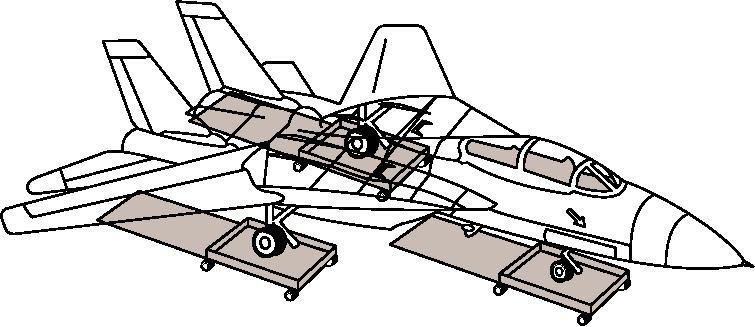
and cargo loads). The complete system is portable and
shows the meaning of and relationships between
includes a trailer for storage and transport, or it is
aircraft weight terminology. All aircraft are designed
mounted on a single 88- by 108-inch pallet. Typical
with a number of weight limits. Performance, control,
installation setup time by two men is 30 minutes.
and structural restrictions determine these limits.
Exceeding these limits may result in a loss of the
HEAVY-DUTY PORTABLE SCALES.--This
aircraft, and is expressly forbidden.
system is designed to provide weight only. Wheeled
If the aircraft's actual weight exceeds the design
vehicles and cargo may also be weighed on these
weight, the result is reductions in performance and/or
scales. The complete system is portable and completely
payload. An increase in gross weight increases takeoff
self-contained. Platform size is small, but it may be
speed, stalling speed, and landing ground run. The rate
increased by connecting two scales with a factory
of climb, ceiling, and range decreases with increasing
provided channel. Because of the small platforms, you
gross weight. If the operating weight increases while
must exercise care when using this system. Typical
performance requirements remain the same, then the
installation setup time by two men is 10 minutes.
payload and/or fuel load must decrease. The weight of
STATIONARY PIT-TYPE SCALES.--Most of
an aircraft is determined through a combination of
the large scales are of the stationary-beam and
actual weighing, accurate record keeping, and proper
lever-balance type. See figure 1-18. These scales are
use of the aircraft's NAVAIR 01-1B-40.
commonly flush floor installations, although some are
used as surface-type portable scales. The flush floor
Weighing Scales
installation generally is in a permanent location, and the
aircraft must be taken to it. However, some flush floor
A variety of scales and equipment may be used for
scales have the capability to be removed from their
weighing aircraft. At the present time, the method that
installations, when necessary, and taken to the aircraft.
has become the standard is the Mobile Electronic
These scales are usually expensive and normally
Weighing System (MEWS). Weighing systems now
require a special building or hangar.
being used to weigh Navy aircraft are the MEWS, the
heavy-duty portable scales, and the stationary pit-type
Weighing with calibrated scales is the only sure
scales.
method of obtaining an accurate basic weight and
center of gravity location on an aircraft. The large
MOBILE ELECTRONIC WEIGHING SYS-
stationary pit-type scales must be calibrated or certified
TEM (MEWS).--This system, shown in figure 1-17,
correct at least once every 12 months. Heavy-duty
is designed to provide weight data and compute the
portable scales and MEWS scales must be calibrated at
center of gravity of aircraft (as well as wheeled vehicles
least once every 6 months.
AMf01017
Figure 1-17.--Mobile Electronic Weighing System (MEWS).
1-22

